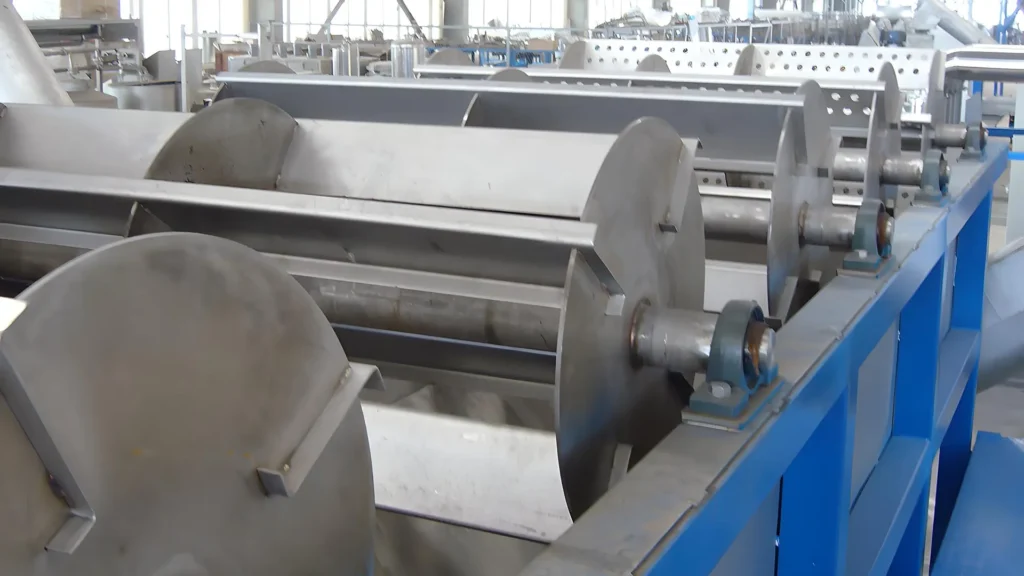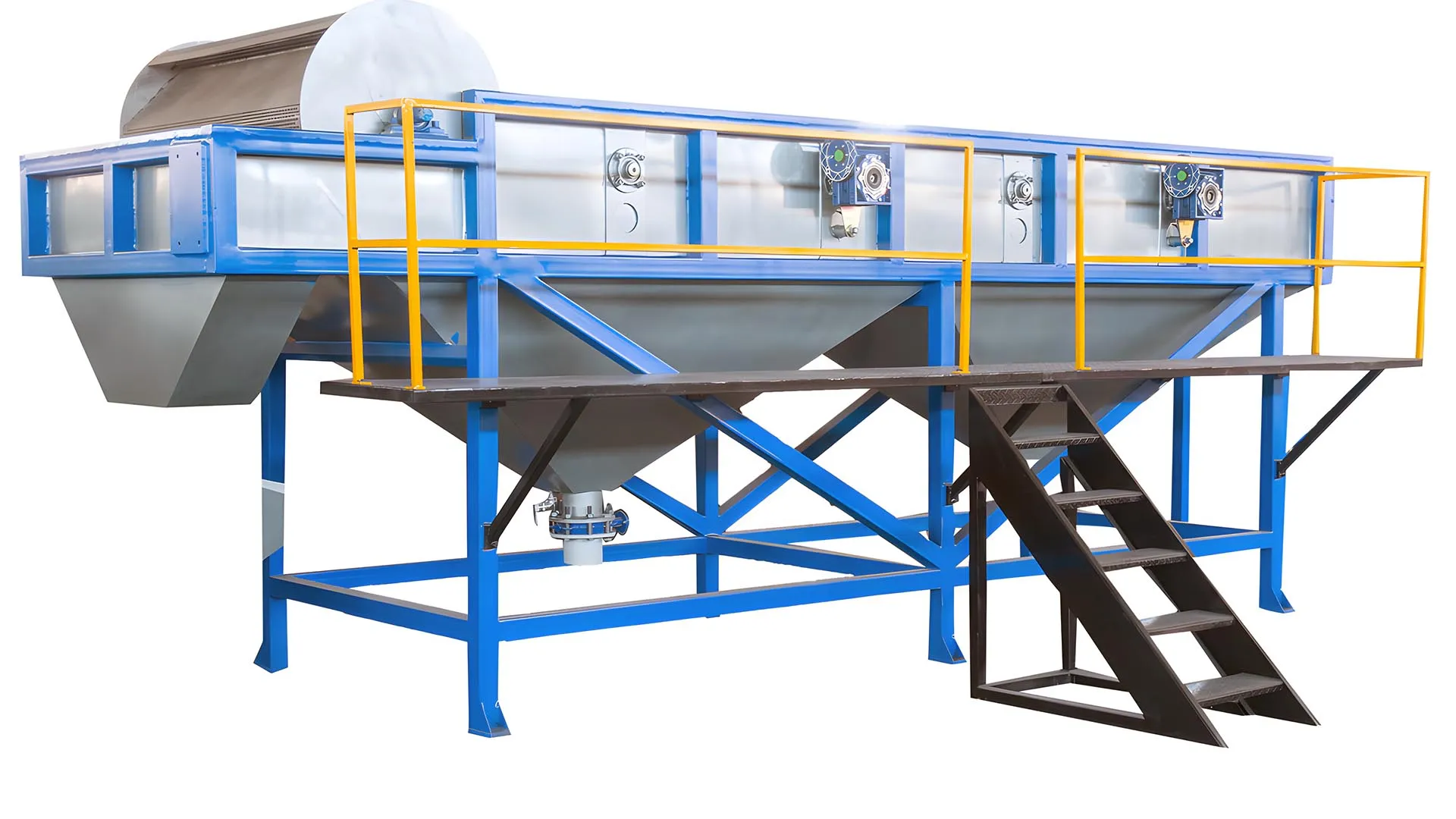Nel mondo del riciclaggio della plastica, la separazione precisa ed efficiente dei diversi tipi di polimeri è fondamentale. Vasca di separazione galleggiante rappresenta una tecnologia fondamentale in questo processo critico. Questo macchinario essenziale sfrutta il semplice ma geniale principio della densità dell'acqua per separare sapientemente materiali come polipropilene (PP) e polietilene (PE) da un flusso di plastica mista. In questo modo, non solo garantisce un'elevata purezza delle plastiche separate, ma esegue anche una pulizia preliminare, preparando i materiali per la successiva fase di riciclo. Esploriamo i meccanismi di questo sistema indispensabile e capiamo perché è fondamentale per un riciclo moderno ed efficace della plastica.
Il ruolo critico del serbatoio di separazione galleggiante
Con la crescente domanda globale di soluzioni sostenibili, la necessità di processi di riciclo della plastica altamente efficienti non è mai stata così urgente. Il Floating Separation Tank affronta direttamente una sfida chiave del settore: separare le plastiche con caratteristiche visive e fisiche molto simili. Dato che PP e PE sono due delle plastiche più diffuse nei beni di consumo e industriali, dai film per imballaggio ai componenti automobilistici, il loro recupero e riciclo di successo hanno un'enorme importanza economica e ambientale. Ottenere un flusso puro di PP e PE è il primo passo verso la produzione di pellet riciclati di alta qualità che possono essere reintrodotti nel settore manifatturiero.
Come funziona il serbatoio di separazione galleggiante?
Il principio della separazione basata sulla densità
Il principio di funzionamento del serbatoio di separazione flottante è elegante nella sua semplicità, ma potente nella sua applicazione. Tutto si riduce alla densità. L'acqua ha una densità di circa 1 g/cm³. Il sistema sfrutta questa costante per distinguere i diversi materiali nel flusso di scaglie di plastica in ingresso.
- Frazioni che affondano (plastiche pesanti): Materiali con densità superiore a quella dell'acqua, come polietilene tereftalato (PET), cloruro di polivinile (PVC) e acrilonitrile butadiene stirene (ABS), precipitano sul fondo del serbatoio. Questa frazione include anche contaminanti non plastici come sporco, pietre, vetro e frammenti metallici, che vengono rimossi efficacemente.
- Frazioni galleggianti (plastiche leggere): Al contrario, le plastiche PP e PE, con densità inferiore a 1 g/cm³, galleggiano sulla superficie dell'acqua. Le pale rotanti in superficie guidano delicatamente questo materiale galleggiante verso un nastro trasportatore di scarico, completando la separazione.
Visualizzazione del flusso di lavoro
Per illustrare meglio il processo, ecco un semplice diagramma del percorso che i materiali compiono all'interno del serbatoio di separazione galleggiante:
Flusso di processo del serbatoio di separazione galleggiante
Fase 1: Alimentazione
I fiocchi di plastica misti entrano nel serbatoio tramite un trasportatore a coclea.
⬇
Fase 2: Agitazione e separazione
Le materie plastiche finiscono nell'acqua. Le frazioni pesanti (PET, PVC, ecc.) affondano. Le frazioni leggere (PP, PE) galleggiano.
⬇
Fase 3: Raccolta
Le pale rotanti spostano il PP/PE galleggiante verso un trasportatore di uscita. I materiali che affondano vengono rimossi dal fondo tramite un trasportatore separato.
⬇
Fase 4: Dimissione
Flussi separati di PP/PE pulito e frazioni pesanti vengono scaricati per ulteriori lavorazioni.
Innovazioni di progettazione per prestazioni migliorate
Il nuovo serbatoio di separazione flottante di Energycle, riprogettato, integra funzionalità avanzate per aumentare l'efficienza di lavaggio e favorire il risparmio idrico. Un'innovazione chiave è l'esclusivo fondo di sedimentazione a "W". Questo design intelligente suddivide efficacemente il serbatoio, creando zone distinte per il trattamento:
- Zona di separazione primaria: Qui viene introdotto il flusso di materiale grezzo e miscelato. Questa sezione è progettata per gestire la maggior parte della contaminazione, consentendo a sporco e detriti pesanti di depositarsi rapidamente. L'acqua in questa sezione può essere filtrata e cambiata più frequentemente per mantenerne l'efficacia.
- Zona di lucidatura secondaria: La plastica galleggiante, relativamente pulita, viene poi trasferita nella seconda metà del serbatoio. Qui, la separazione e la pulizia finali avvengono in acqua molto più pulita, garantendo un prodotto finale di maggiore purezza con un consumo d'acqua complessivo significativamente inferiore.
Specifiche tecniche
Per scegliere il serbatoio di separazione flottante più adatto, è necessario esaminarne attentamente le specifiche tecniche per garantire la perfetta compatibilità con le vostre esigenze operative. Di seguito sono riportate le specifiche standard dei nostri modelli:
| Caratteristica | Specificazione |
|---|---|
| Larghezza interna | 1000mm – 1800mm |
| Lunghezza totale | 4 – 7 metri |
| Materiale interno | Acciaio inossidabile tipo 304 (per resistenza alla corrosione) |
| Telaio esterno | Acciaio al carbonio per impieghi gravosi (per l'integrità strutturale) |
| Motori a pale | 1,5 KW*2 (con controllo di frequenza per velocità regolabile) |
| Certificazione | Certificazione CE disponibile |
Nota bene: sappiamo che ogni linea di riciclaggio è unica. Modelli più grandi e potenti possono essere progettati su misura in base alle vostre specifiche esigenze, offrendo la massima flessibilità per adattarsi a diversi tipi di materiali e a diverse esigenze di produttività.

Conclusione: un investimento essenziale per un riciclaggio di qualità
Il separatore flottante è molto più di una semplice vasca; è una macchina sofisticata e indispensabile in qualsiasi importante operazione di riciclo delle materie plastiche. La sua solida capacità di separare in modo pulito PP e PE di valore da altri polimeri e contaminanti lo rende un componente fondamentale per la creazione di un prodotto riciclato di alta qualità e commercialmente valido. Grazie a innovazioni progettuali moderne che migliorano sia l'efficienza di separazione che la sostenibilità ambientale, investire in un separatore flottante Energycle è un passo strategico verso l'ottimizzazione delle capacità di lavorazione e della redditività del vostro impianto.
Richiedi un preventivo
Pronti a potenziare la vostra linea di riciclaggio? Per conoscere i prezzi e i tempi di consegna aggiornati sulla nostra gamma di vasche di separazione flottanti, contattate il nostro team di esperti utilizzando il modulo sottostante. Siamo qui per aiutarvi a trovare la soluzione perfetta per le vostre esigenze.



